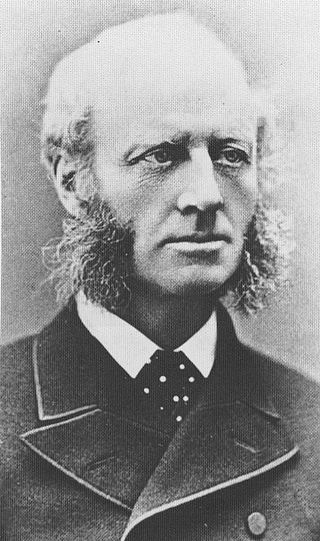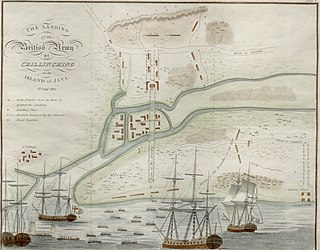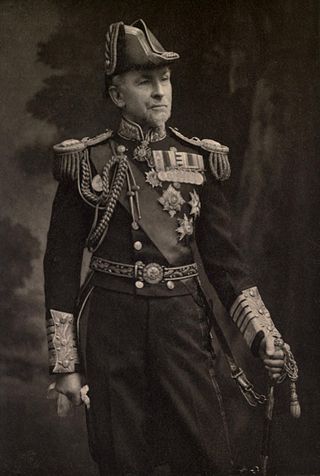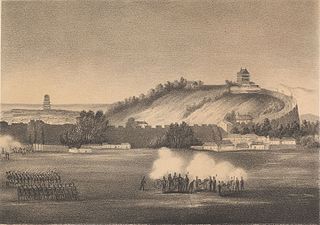
The Second Opium War, also known as the Second Anglo-Chinese War or Arrow War, was fought between the United Kingdom and France against the Qing dynasty of China between 1856 and 1860. It was the second major conflict in the Opium Wars, which were fought over the right to import opium to China, and resulted in a second defeat for the Qing Mandate and the forced legalization of the opium trade. It caused many Chinese officials to believe that conflicts with the Western powers were no longer traditional wars, but part of a looming national crisis.

Sir Harry Smith Parkes was a British diplomat who served as Envoy Extraordinary and Minister Plenipotentiary and Consul General of the United Kingdom to the Empire of Japan from 1865 to 1883 and the Chinese Qing Empire from 1883 to 1885, and Minister to Korea in 1884. Parkes Street in Kowloon, Hong Kong is named after him.

The invasion of Java was a successful British amphibious operation against Java in the Dutch East Indies between August and September 1811 during the Napoleonic Wars. Originally established as a colony of the Dutch East India Company, Java remained in Dutch hands throughout the French Revolutionary Wars, during which the French invaded the Dutch Republic, transforming it into the Batavian Republic in 1795 and the Kingdom of Holland in 1806. The Kingdom of Holland was annexed to the First French Empire in 1810, and Java became a French colony, though it continued to be administered and garrisoned primarily with Dutch personnel.

Admiral of the Fleet Sir Edward Hobart Seymour, was a Royal Navy officer. As a junior officer he served in the Black Sea during the Crimean War. He then took part in the sinking of the war-junks, the Battle of Canton and the Battle of Taku Forts during the Second Opium War and then saw action again at the Battle of Cixi during the Taiping Rebellion.

HMS Hornet was a 17-gun wooden screw sloop of the Cruizer class of the Royal Navy, launched in 1854 and broken up in 1868.

The Battle of the Taku or Battle of Dagu Forts was a short engagement during the Boxer Rebellion between the Chinese Qing dynasty military and forces belonging to the Eight Nation Alliance in June 1900. European and Japanese naval forces captured the Taku forts after a brief but bloody battle with units of the Qing dynasty. Their loss prompted the Qing government to side with the Boxers while the Chinese army was ordered to resist all foreign military forces within Chinese territory. Allied powers remained in control of the forts until the end of the Boxer Rebellion in September 1901.

William Thornton Bate was a British Royal Navy officer and surveyor. He served in First Anglo-Chinese War and Second Anglo-Chinese War. He died during the Battle of Canton in 1857.

HMS Coromandel was a wooden paddle dispatch vessel of the Royal Navy. She was built for the P&O company as the passenger and cargo steamer Tartar. The Navy purchased her in 1855 and she participated in several battles in Chinese waters, including having been sunk and recovered. The Navy sold her in 1866 and she went through several changes in ownership before she was broken up in 1876.

The Battle of the Barrier Forts was fought between American and Chinese forces in the Pearl River, Guangdong, China in November 1856 during the Second Opium War. The United States Navy launched an amphibious assault against a series of four forts known as the Barrier Forts near the city of Canton. It was considered an important battle by the British whose interest lay in capturing Canton.

The Second Battle of Chuenpi was fought between British and Chinese forces in the Pearl River Delta, Guangdong province, China, on 7 January 1841 during the First Opium War. The British launched an amphibious attack at the Humen strait (Bogue), capturing the forts on the islands of Chuenpi and Taikoktow. Subsequent negotiations between British Plenipotentiary Charles Elliot and Chinese Imperial Commissioner Qishan resulted in the Convention of Chuenpi on 20 January. As one of the terms of the agreement, Elliot announced the cession of Hong Kong Island to the British Empire, after which the British took formal possession of the island on 26 January.

The Battle of the Bogue was fought between British and Chinese forces in the Pearl River Delta, Guangdong province, China, on 23–26 February 1841 during the First Opium War. The British launched an amphibious attack at the Humen strait (Bogue), capturing the forts on the islands of Anunghoy and North Wangtong. This allowed the fleet to proceed further up the Pearl River towards the city of Canton (Guangzhou), which they captured the following month.

Vice-Admiral Sir Thomas Herbert, KCB, was a British Royal Navy officer. He served in the Napoleonic Wars, War of 1812, and First Anglo-Chinese War. From 1847 to 1849, he was commodore of the South East Coast of America Station. Herbert served as Member of Parliament for Dartmouth as a Conservative from 1852 to 1857.

Captain Sir Humphrey Fleming Senhouse was a British Royal Navy officer. He served in the Napoleonic Wars, War of 1812, and First Anglo-Chinese War. In China, he was the senior naval officer of the British fleet from 31 March 1841 until his death on board his flagship, HMS Blenheim, in Hong Kong from fever contracted during the capture of Canton.

The Commander-in-Chief, East Indies and China was a formation of the Royal Navy from 1831 to 1865. Its naval area of responsibility was the Indian Ocean and the coasts of China and its navigable rivers.

The Battle of the Bogue was fought between British and Chinese forces at the Humen strait (Bogue), Guangdong province, China, on 12–13 November 1856 during the Second Opium War. The British captured the forts in the Wangtong Islands on 12 November and the forts in Anunghoy Island the next day.

The Battle of Canton was fought by British and French forces against Qing China on 28–31 December 1857 during the Second Opium War. The British High Commissioner, Lord Elgin, was keen to take the city of Canton (Guangzhou) as a demonstration of power and to capture Chinese official Ye Mingchen, who had resisted British attempts to implement the 1842 Treaty of Nanking. Elgin ordered an Anglo-French force to take the town and an assault began on 28 December. Allied forces took control of the city walls on 29 December but delayed entry into the city itself until 5 January. They subsequently captured Ye and some reports state they burnt down much of the town. The ease with which the allies won the battle was one of the reasons for the signing of the Treaty of Tientsin in 1858.

HMS Encounter was ordered as a First-Class Sloop with screw propulsion on 5 February 1845 to be built at Pembroke, in accordance with the design developed by John Fincham, Master Shipwright at Portsmouth. Her armament was to consist of 8 guns. She was to have a more powerful steam engine rated at 360 nominal horsepower. In 1848 she would be altered abaft and lengthened at Deptford prior to completion. A second vessel (Harrier) was ordered on 26 March 1846 but after her keel was laid at Pembroke Dockyard, her construction was suspended on 9 September 1846 then cancelled five years later, on 4 April 1851. Encounter had her armament radically altered in 1850 and she was broken up at Devonport in 1866.

The Capture of the French Folly Fort by British forces in China occurred on 6 November 1856 during the Second Opium War. The British dispersed 23 Chinese war junks and captured the French Folly fort in the Pearl River near the city of Canton (Guangzhou) in Guangdong province. The battle lasted nearly an hour. The British consul Harry Parkes described the Chinese as putting up "a very hot resistance" and the engagement as "exceeding creditable to the bravery not only of our men, but of the Chinese also."

The Battle of Macao Fort was fought between British and Chinese forces in the Pearl River, Guangdong, China on 4 January 1857 during the Second Opium War. Macao Fort was located on an islet about 3 miles south of Canton (Guangzhou).

The invasion of the Spice Islands was a military invasion by British forces that took place between February and August 1810 on and around the Dutch owned Maluku Islands also known as the Spice Islands in the Dutch East Indies during the Napoleonic wars.























